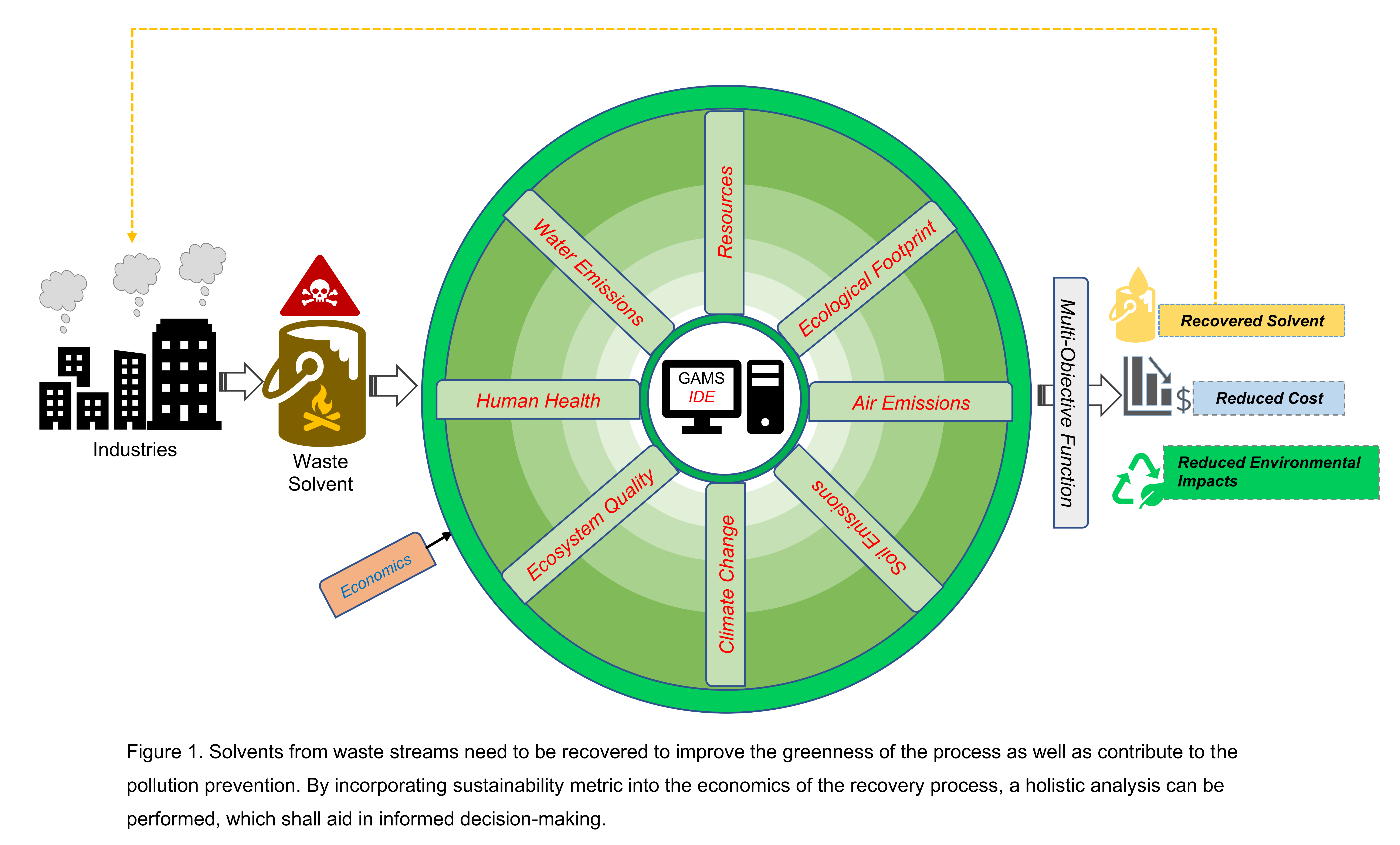(693a) Designing Efficient Solvent Recovery Pathways By Integrating Economics and Environmental Metrics
AIChE Annual Meeting
2020
2020 Virtual AIChE Annual Meeting
Sustainable Engineering Forum
Sustainable Management and Uses of Post-Consumer Materials and Waste
Tuesday, November 17, 2020 - 8:00am to 8:15am
Solvents are used widely for industrial processes. Their use and disposal have a significant impact on the environment, directly and indirectly. Most solvents end up in the waste streams of industrial processes (Righi et al., 2018; Tozzi et al., 2018). Their release into the environment has adverse effects on human health, ecosystem quality, climate change, and resources(Goedkoop and Spriensma, 2001). These effects can be quantified as emissions from the air, water, and soil associated with the processing and disposal of hazardous solvents. One of the ways to measure the environmental impacts of hazardous waste materials is through their life cycle assessment (LCA) that can characterize emissions over the entire life of a product. During a life cycle assessment, midpoint impacts characterization such as carcinogens, ecotoxicity, eutrophication, global warming, non-carcinogens, respiratory effects, and acidification are assessed (Jolliet et al., 2003). These midpoint categories are further grouped into three or four main damage assessment or endpoint categories. By assessing the life cycle of a product, various environmental decisions can be implemented to reduce emissions and impacts associated with hazardous solvent wastes. Traditional methods of waste solvent disposal, such as incineration has proved to be less favorable to the environment. It has, therefore, become imperative to develop new ways of hazardous solvent waste disposal, hence solvent recovery.
Although solvent recovery processes improve the cost and sustainability, there has not been an integrated method to simultaneously quantify the environmental impacts and economics of the process. A multi-objective optimization approach, which helps to solve problems with multiple objective functions, is one of the tools that can be implemented (Diwekar, 2013). Previous work on the evaluation of the economic feasibility of the solvent recovery options has already been accomplished (Chea et al., 2020). This work is an extension of the previous study where we incorporate the sustainability matrix into the framework. This is implemented by using a multi-objective optimization approach. The sustainability index used is the Sustainable Process Index (SPI). SPI is an ecological footprint that quantifies the arable area needed to provide goods and services. Every process requires a certain area within the ecosystem to take place. The SPI is made up of seven footprints, quantified as area, namely: (i) area needed for installations and infrastructure, (ii) area for renewable resources, (iii) area for non-renewable resources, (iv) area for fossil carbon usage, (v) areas to embed air, (vi) water, and (vii) soil emissions after the process(Krotscheck and Narodoslawsky, 1996; Narodoslawsky and Krotscheck, 1995). The larger the area needed to process a material into a desired product, the less sustainable the process is in terms of the ecological footprint. This is the basic concept on which the SPI methodology is built upon.
In many studies, we observe that the economic evaluation is at the forefront of process selection, however, when we are targeting recovery from waste streams, as in case of solvent-containing streams, along with meeting the minimum cost requirements we also need to ensure that we are not posing an additional burden on our ecosystem. Thus, we integrated the mathematical models quantifying the SPI of each recovery technology along with its economics and formulated a multi-objective optimization problem for minimizing the costs as well as the ecological footprint. Furthermore, CO2 and other greenhouse gases (GHGs) were added to the model. This system of equations was modeled using the constraint-based optimization approach in General Algebraic Modeling System (GAMS) software.
References
Chea, J.D., Lehr, A.L., Stengel, J.P., Savelski, M.J., Slater, C.S., Yenkie, K.M., 2020. Evaluation of Solvent Recovery Options for Economic Feasibility through a Superstructure-Based Optimization Framework. Ind. Eng. Chem. Res. 59, 5931–5944. https://doi.org/10.1021/acs.iecr.9b06725
Diwekar, U., 2013. Introduction to Applied Optimization. Springer Science & Business Media.
Goedkoop, M., Spriensma, R., 2001. 22 June 2001 Third edition 87.
Jolliet, O., Margni, M., Charles, R., Humbert, S., Payet, J., Rebitzer, G., Rosenbaum, R., 2003. IMPACT 2002+: A new life cycle impact assessment methodology. Int. J. Life Cycle Assess. 8, 324–330. https://doi.org/10.1007/BF02978505
Krotscheck, C., Narodoslawsky, M., 1996. The Sustainable Process Index a new dimension in ecological evaluation. Ecol. Eng. 6, 241–258. https://doi.org/10.1016/0925-8574(95)00060-7
Narodoslawsky, M., Krotscheck, C., 1995. The sustainable process index (SPI): evaluating processes according to environmental compatibility. J. Hazard. Mater., Selected papers presented at the Conference on Hazardous Waste Remediation 41, 383–397. https://doi.org/10.1016/0304-3894(94)00114-V
Righi, S., Baioli, F., Dal Pozzo, A., Tugnoli, A., 2018. Integrating Life Cycle Inventory and Process Design Techniques for the Early Estimate of Energy and Material Consumption Data. Energies 11, 970. https://doi.org/10.3390/en11040970
Tozzi, P.V., Wisniewski, C.M., Zalewski, N.J., Savelski, M.J., Slater, C.S., Richetti, F.A., 2018. Life cycle assessment of solvent extraction as a low-energy alternative to distillation for recovery of N-methyl-2-pyrrolidone from process waste. Green Process. Synth. 7, 277–286. https://doi.org/10.1515/gps-2017-0030
